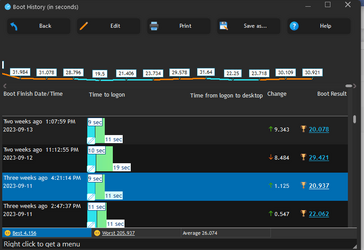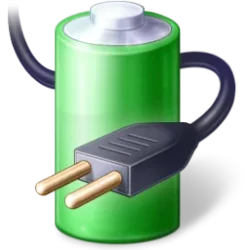Really? As mentioned before:
F=9/5 C +32. (F=1.8C +32.)
Memory is inexplicable. I still recall Planck's constant (6.63 E-34 Js). Why? A Web search would produce it as fast as I could type the query.
I do this in my head, but fast ways of estimation is 5° C == 9° F, and adding / subtracting the 32 as needed, and you're close. So, if it is 37° C, estimate ends up being (7*9) + 32, plus ~4, or 99° C - and it's actually 98.6.
The other thing is to memorize the tens - 10 °C = 50, and for every 10° C add 18° F. 50, 68, 86, 104, 122, 140....
The 980 PRO is the way to go if you have a GEN 4 platform; but if all you have is PCIe GEN 3 and you don't plan on moving up to GEN 4 then it's really pointless to pay the premium for 980 PRO. Don't get my wrong, I love my SAMSUNG PRO silicon in my GEN 4 unit. Glasskuter will never see these speeds on their GEN 3 platform, which limits out at 3500. Just sayin'.
Future proofing. Why stick with a gen 3 drive that may need to be moved to a newer device later on, if there is no reason to? The price difference is negligible, and unless there is a reason that a gen 4 device will not work in a gen 3 slot (there isn't), absolutely 0 reason to consider a gen 3 drive.
The biggest reason to not buy Gen 5 drives is price - the difference between 4 and 5 right now is staggering, so it would be a waste of money in that sort of a scenario. But gen 4 has been out for a good while now, at the very least 3 years, as that is when I built my machine, and I'm pretty sure it's closer to 5 (without actually looking). Given the fact that the drives are backward compatible, the only issue is price. Since they are very similar, more advantageous to get the newer gen 4 drive.
@glasskuter - glad you found what you wanted at a reasonably good price, too. I'd read about then but have not had the opportunity to use their drives yet, I suspect I may go with them, if not SK Hynix direct, for my next drive upgrade or build.
Enjoy!
My Computers
System One System Two
-
- OS
- Windows 11 23H2 Current build
- Computer type
- PC/Desktop
- Manufacturer/Model
- HomeBrew
- CPU
- AMD Ryzen 9 3950X
- Motherboard
- MSI MEG X570 GODLIKE
- Memory
- 4 * 32 GB - Corsair Vengeance 3600 MHz
- Graphics Card(s)
- EVGA GeForce RTX 3080 Ti XC3 ULTRA GAMING (12G-P5-3955-KR)
- Sound Card
- Realtek® ALC1220 Codec
- Monitor(s) Displays
- 2x Eve Spectrum ES07D03 4K Gaming Monitor (Matte) | Eve Spectrum ES07DC9 4K Gaming Monitor (Glossy)
- Screen Resolution
- 3x 3840 x 2160
- Hard Drives
- 3x Samsung 980 Pro NVMe PCIe 4 M.2 2 TB SSD (MZ-V8P2T0B/AM) } 3x Sabrent Rocket NVMe 4.0 1 TB SSD (USB)
- PSU
- PC Power & Cooling’s Silencer Series 1050 Watt, 80 Plus Platinum
- Case
- Fractal Design Define 7 XL Dark ATX Full Tower Case
- Cooling
- Arctic Liquid Freezer III 420 RGB + Air 3x 140mm case fans (pull front) + 1x 120 mm (push back) and 1 x 120 mm (pull bottom)
- Keyboard
- SteelSeries Apex Pro Wired Gaming Keyboard
- Mouse
- Logitech MX Master 3S | MX Master 3 for Business
- Internet Speed
- AT&T LightSpeed Gigabit Duplex Ftth
- Browser
- Nightly (default) + Firefox (stable), Chrome, Edge , Arc
- Antivirus
- Defender + MB 5 Beta
-
- Operating System
- ChromeOS Flex Dev Channel (current)
- Computer type
- Laptop
- Manufacturer/Model
- Dell Latitude E5470
- CPU
- Intel(R) Core(TM) i5-6300U CPU @ 2.40GHz, 2501 Mhz, 2 Core(s), 4 Logical Processor(s)
- Motherboard
- Dell
- Memory
- 16 GB
- Graphics card(s)
- Intel(R) HD Graphics 520
- Sound Card
- Intel(R) HD Graphics 520 + RealTek Audio
- Monitor(s) Displays
- Dell laptop display 15"
- Screen Resolution
- 1920 * 1080
- Hard Drives
- Toshiba 128GB M.2 22300 drive
INTEL Cherryville 520 Series SSDSC2CW180A 180 GB SATA III SSD
- PSU
- Dell
- Case
- Dell
- Cooling
- Dell
- Mouse
- Logitech MX Master 3S (shared w. Sys 1) | Dell TouchPad
- Keyboard
- Dell
- Internet Speed
- AT&T LightSpeed Gigabit Duplex Ftth













